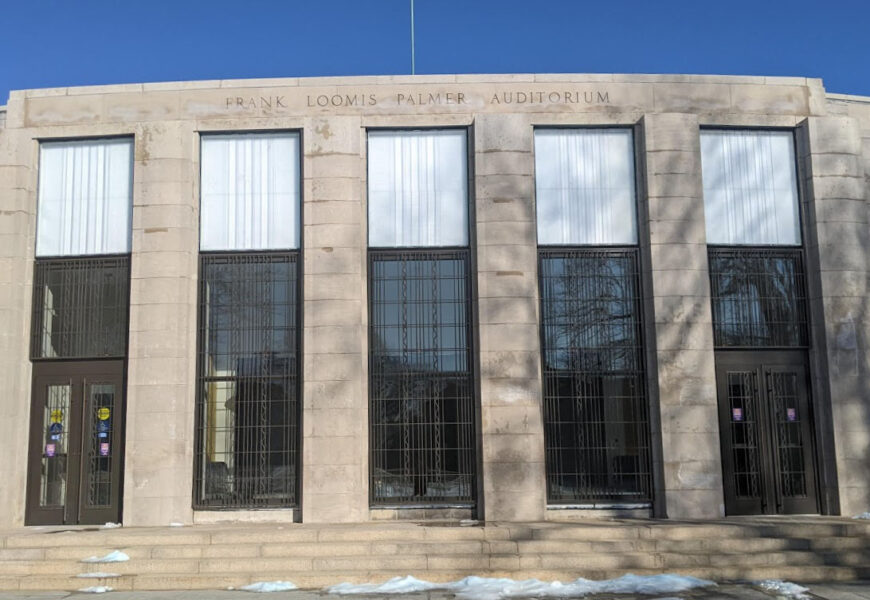Photo courtesy of Catja Christensen.
Despite having already been the venue of the Theater department’s production of Cabaret, the Dance department’s Senior Capstone performance If We Could Turn Back Time, among other performances and events, on April 29, The Athey Center for Performance and Research at Palmer Auditorium officially opened its doors to the Connecticut College community. The Palmer Auditorium reopening was one of many projects that Conn hoped to complete with the help of donors. The evening opened with a bang, featuring a powerful video about Connecticut College’s large fundraising campaign, Defy Boundaries, and a speech from President Katherine Bergeron.
As President Bergeron shared in her opening remarks, the original Palmer Auditorium was completed in 1939 by Shreve, Lamb, and Harmon, the architects of the Empire State Building. The construction of the theater was an ambitious undertaking. Although there were only 750 students enrolled at Conn at the time, the new auditorium would include a 1300 seat theater. This would allow Connecticut College, and New London as a whole, to be an attractive and important location for artists to perform. In the theater’s eighty year history, many impressive performers, such as The New York Philharmonic, Martha Graham, Alvin Ailey, Yo-Yo Ma, and Billy Joel, have graced the Palmer stage with their performances.
The student performing artists at Conn are so lucky to be able to share this historically rich space with such talented artists. The spirit of excellent performance art was carried on by the performances of the evening, which included six ten minute pieces: three performances by current students in the Theater, Music, and Dance departments, and three Conn alumni from the performing arts disciplines. The performance art departments also invited back an alumna to stage manage the evening.
The Theater department’s medley performance of Cabaret kicked off the program, featuring a handful of songs and choreography from the musical. While not all of the cast members could participate in the medley, the characters who were present were still entertaining to watch and authentic to their roles.
As one of the dancers in the medley performance, I was disappointed to miss the second performance by Stephanie Poster ‘18, who sang “Tornami a vagheggiar,” from Alcina by George Frideric Handel, and “Quando m’en vo” from La Boheme by Giacomo Puccini.
Following Foster, the Connecticut College Camerata performed a selection of songs including “Da hai a gu Xiang” by Wang Li-Ping, arr Yang, “The Jungle Flower” by Harry T. Burleigh, arr. Garrett, and “The Storm Is Passing Over” by Charles Albert Tindley, arr. Baker. Led by director Rachel Feldman, the treble singer’s energy gave the evening a pleasant and uplifting feel.
Dance alumnus Aaron Samuel Davis ‘14 performed a dance piece in which he reflected on his experience with the Dance department, mentioning that Conn was where he learned about post-modern dance, or the idea that dance can be anything. He invited the audience to participate in the dance by feeling the beat of their own hearts and singing along with him. Davis utilized speech and singing in his performance in addition to more traditional dance movements.
The last alumni of the evening was Malik Work ‘98, who performed sections from Verses @ Work, created and performed by Work, and directed by Vernice Miller. The powerfully delivered piece contained personal anecdotes on love, hope, and dreams. Work’s striking delivery and use of rhyme and rhythm encapsulated the audience.
The final performance of the show was Elisabeth Wales’ ‘22 Dance department senior Capstone project. The dance was a commentary on whose voices are heard and whose stories are told. The work featured a large group of dancers, performing in a strong, collective manner, making it an exciting closer to the show.
Overall the evening was an exciting reminder of how powerful and important performance art is in our lives. It forces us to come together, think harder, and see more. We are lucky to be able to take advantage of the new resources the Athey Center for Performance and Research provides us with, and continue to grow the impressive legacy of Palmer Auditorium.









